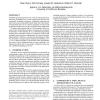4722 search results - page 7 / 945 » Representation-independent program analysis |
SIGSOFT
2010
ACM
13 years 5 months ago
2010
ACM
We present an effective dynamic analysis for finding a broad class of deadlocks, including the well-studied lock-only deadlocks as well as the less-studied, but no less widespread...
PLDI
2011
ACM
12 years 10 months ago
2011
ACM
We present a strictly bottom-up, summary-based, and precise heap analysis targeted for program verification that performs strong updates to heap locations at call sites. We firs...
CIDR
2011
12 years 11 months ago
2011
Distributed programming has become a topic of widespread interest, and many programmers now wrestle with tradeoffs between data consistency, availability and latency. Distributed...
ACSC
2005
IEEE
14 years 1 months ago
2005
IEEE
Support for program understanding in development and maintenance tasks can be facilitated by program analysis techniques. Both control-flow and data-flow analysis can support pr...
POPL
2010
ACM
14 years 5 months ago
2010
ACM
The method of logical relations is a classic technique for proving the equivalence of higher-order programs that implement the same observable behavior but employ different intern...

